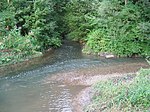Detmold Open-air Museum
DetmoldMuseums in North Rhine-WestphaliaNorth Rhine-Westphalia building and structure stubsOpen-air museums in Germany

The Detmold Open-air Museum (German: LWL-Freilichtmuseum Detmold – Westfälisches Landesmuseum für Volkskunde; English: "LWL Open-air Museum Detmold – Westphalian State Museum for Folkloristics") is a museum at Detmold in the Ostwestfalen-Lippe region of North Rhine-Westphalia, Germany. It was founded, together with the Hagen Open-air Museum, in 1960, and was first opened to the public in the early 1970s. The museum is run by the Landschaftsverband Westfalen-Lippe (LWL, regional authority for Westphalia and Lippe within North Rhine-Westphalia).
Excerpt from the Wikipedia article Detmold Open-air Museum (License: CC BY-SA 3.0, Authors, Images).Detmold Open-air Museum
Paderborner Straße,
Geographical coordinates (GPS) Address Nearby Places Show on map
Geographical coordinates (GPS)
| Latitude | Longitude |
|---|---|
| N 51.923611111111 ° | E 8.87 ° |
Address
Wassermühle
Paderborner Straße
32760 , Detmold-Süd
North Rhine-Westphalia, Germany
Open on Google Maps










